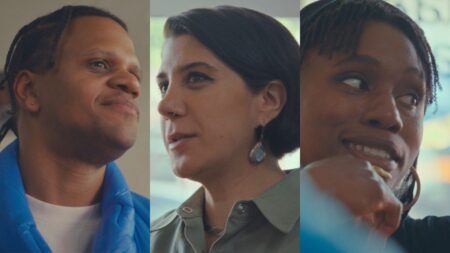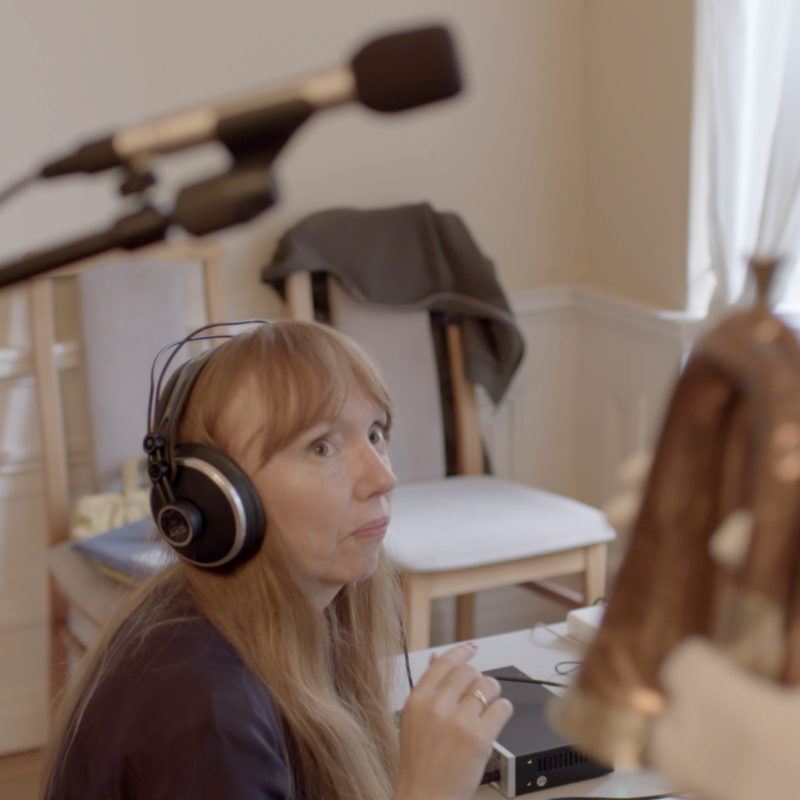Continue playing
(Time remaining: )
Play from beginning
Continue playing "{{ controller.videos[controller.getVideo(controller.currentVideo)].segmentParentTitle}}"
{{controller.videos[controller.getVideo(controller.currentVideo)].title}} has ended.
Susan Philipsz in "Berlin"
Susan Philipsz treats audio as a sculptural object, using historically-resonant sources—like an orchestral work by a composer who was interned in a German concentration camp in the 1940s—to create unexpectedly haunting and lyrical installations. Philipsz develops a series of projects across Germany and Austria, including the rehearsal of World War II–damaged instruments in a small German town and a new work connecting one of Vienna’s best-known public squares to its fascist past.
Credits
Executive Producer: Tina Kukielski. Series Producer: Nick Ravich. Directors: Rafael Salazar & Ava Wiland. Producer: Ava Wiland. Editor: Thomas Niles. Director of Photography: Rafael Salazar.
Production Coordinator: Ife Adelona. Curatorial Assistant: Danielle Brock. Advising Producer: Ian Forster.
Title Sequence & Typography: Afternoon Inc. Composer: Joel Pickard. Narration: Carrie Mae Weems. Additional Photography: Rehana Esmail, Christoph Lerch, & Anne Misselwitz. Aerial Camera: Martin Paschkowski. Sound: Jaime Guijarro-Bustamante. Additional Sound: Rasmus Damsgaard, Marc Parisotto, Fokke van Saane, & Ava Wiland. Production Assistant: Flavia Barragan Clavero, Claudia Gülzow, Tim Oppermann, & Manuel Schmit.
Digital Intermediate: Blue Table Post. Post-Production Producer: Oliver Lief. Colorist: Natacha Ikoli. Re-Recording Mixer & Dialogue Editor: Rich Cutler. Additional Animation: Andy Cahill. Assistant Editor: Caroline Berler, Adam Boese, Maya Elany, & Jonah Greenstein. Technical Evaluation: Pillar To Post. Translation: Rehana Esmail & Ridwan Zebari.
Artwork Courtesy: Nathalie Djurberg & Hans Berg, Olafur Eliasson, Hiwa K, Susan Philipsz, KOW, Lisson Gallery, & Tanya Bonakdar Gallery. Eliasson Artwork: “Cirkelbroen,” Copenhagen, 2015; “Din blinde passager (Your blind passenger),” ARKEN Museum of Modern Art, Copenhagen, 2010; “Ice Watch,” Place du Panthéon, Paris, 2015; “Map for unthought thoughts,” Fondation Louis Vuitton, Paris, 2014; Rainbow assembly, Leeum, Samsung Museum of Art, Seoul, 2016; “Reality projector,” Marciano Foundation, Los Angeles, 2018; “Riverbed,” Louisiana Museum of Modern Art, Humlebæk, Denmark, 2014; “Sphere,” Fünf Höfe, Viscardihof, Munich, 2003; “The weather project,” Tate Modern, London, 2003; “Umschreibung,” KPMG Deutsche Treuhand-Gesellschaft, Munich, 2004; “Vejr i vejret,” Ordrupgaard Kunstpark, Denmark, 2016; “Wirbelwerk,” Lenbachhaus, Munich, 2011; “Your rainbow panorama,” ARoS Aarhus Kunstmuseum, Denmark, 2011; “Your split second house,” 12th International Architecture Exhibition of La Biennale di Venezia, Venice, 2010.
Archival Materials: 47 Film / Andy Cameron; BBC Motion Gallery / Getty Images; Critical Past; Footage of Olafur Eliasson’s “Waterfall, Versailles, 2016 by Barbara Fecchio, Courtesy of Sculpture Nature; Internationale Filmfestspiele Berlin; Newsroom GmbH / Max Roehrle; NPR; Olafur Eliasson interview courtesy Public Art Fund; Pond5; SHIMURAbros; Studio Olafur Eliasson; Transit Film; & Walker Art Center / Andy Underwood.
Additional Art21 Staff: Maggie Albert, Lindsey Davis, Lolita Fierro, Joe Fusaro, & Jonathan Munar. Interns: Diane Huerta, Esther Knuth, Sunny Leerasanthanah, & Kristopher Neira. Public Relations: Sutton. Station Relations: De Shields Associates, Inc. Legal Counsel: Barbara T. Hoffman, Esq.
Special Thanks: The Art21 Board of Trustees, Leila Akhmetova, Bakir Ali, Bettina Bärnighausen, Sebastian Behmann, Finn Bergquist, Thomas Blees. Rainer Brennecke, Johanna Chromik, CityQuartier FÜNF HÖFE, De Appel, Ina Dinter, Documenta 14, Joel Draper, Caroline Eggel, Jeremy Eichenbaum , El Otmani Gym, Anna Engberg-Pedersen, Emilie Engbirk, Anna Fedotova, Guillermo F. Florez, Annie Claire Geisinger , Glasgow International Festival of Visual Art, Nora Gomez-Strauss, Marina Greiner , Felix Hallwachs, Christine Hauptsummer , Haus der Geschichte Österreich, Lauren Jack, Patricia Kamp, Wanås Konst, KPMG Deutsche Treuhand-Gesellschaft Munich, Camilla Kragelund, KW Institute for Contemporary Art, Sharron Lee, Clara Jungman Malmquist, Julia Jungman Malmquist , Marciano Art Foundation, Augustin Maurs , Eoghan McTigue, Alan Miller, Elisabeth Millqvist , Museum Frieder Burda | Salon Berlin, Nationalgalerie im Hamburger Bahnhof, Alexander Psavke, Sara Roffino, Schlossmuseum Sondershausen, Emily Skeppner, United States Holocaust Memorial Museum, Niels Van Tomme , Lucie von Eugen, Jill Vuchetich, Wanås Konst, Sven Weigel, Wolfgang Wenke, Robin Woerlen-Leikam, Michaela Zach, & Katja Zeidler.
Series Created By: Susan Dowling & Susan Sollins.
Major support for Season 9 is provided by National Endowment for the Arts, PBS, Lambent Foundation, Agnes Gund, Ford Foundation, The Andy Warhol Foundation for the Visual Arts, The Anna-Maria and Stephen Kellen Foundation, The Horace W. Goldsmith Foundation, Toby Devan Lewis, Nion McEvoy, and The Phyllis C. Wattis Foundation.
Closed captionsAvailable in English, German, Romanian, Italian, Japanese, Korean, Chinese, Italian
Through the Art21 Translation Project, multilingual audiences from around the globe can contribute translations, making Art21 films more accessible worldwide. Translate this video now.
Interested in showing this film in an exhibition or public screening? To license this video please visit Licensing & Reproduction.
Susan Philipsz was born in Glasgow, Scotland, in 1965. Philipsz’s work explores the psychological and sculptural dimensions of sound, with recordings of her voice and a variety of reworked musical compositions. Interested in the power of sound to trigger emotion, Philipsz responds to the architecture and history of the spaces in which her pieces are installed; her works prompt introspection and an examination of personal and collective memories, losses, and yearnings.
“I thought of songs as found objects. Singing them unaccompanied and then placing them in a particular context could make you see the place in a new way.”
Susan Philipsz

